

Three Ways to Boost Collaboration in Student Projects. The Importance of Preparing Students for Life After Graduation Through Collaborative Learning. Kathy Murphy, a seventh-grade math teacher in Worchester, MA, often has both students and parents question her about the value of her group work assignments.
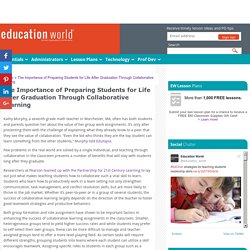
It’s only after presenting them with the challenge of explaining what they already know to a peer that they see the value of collaboration. “Even the kid who thinks they are the top student can learn something from the other students,” Murphy told Edutopia. Few problems in the real world are solved by a single individual, and teaching through collaboration in the classroom presents a number of benefits that will stay with students long after they graduate. 7 collaboration tools for the modern classroom. Technology can support students as they develop their collaboration skills.
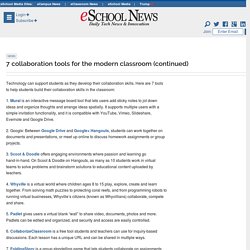
Here are 7 tools to help students build their collaboration skills in the classroom: 1. Collaborative Learning Spaces: Classrooms That Connect to the World. Editor's note: This post is co-authored by Fran Siracusa, co-founder of and educational technologist for Calliope Global.
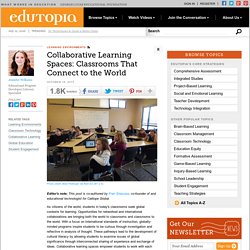
As citizens of the world, students in today's classrooms seek global contexts for learning. Opportunities for networked and international collaborations are bringing both the world to classrooms and classrooms to the world. With a focus on international standards of instruction, globally-minded programs inspire students to be curious through investigation and reflective in analysis of thought. These pathways lead to the development of cultural literacy by allowing students to examine issues of global significance through interconnected sharing of experience and exchange of ideas.
Video: Collaboration vs. Cooperative Learning - Inspired Instruction: Videos From the Teaching Channel. Collaborative Learning Spaces™ Laura Candler's Cooperative Learning Resources. What children can do together today, they can do alone tomorrow. ~ Lev Vygotsky, 1962 Cooperative learning is a powerful teaching strategy that's more than just a passing fad.
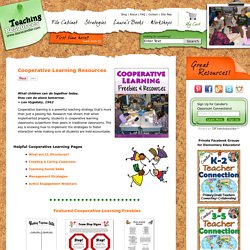
Research has shown that when implemented properly, students in cooperative learning classrooms outperform their peers in traditional classrooms. The key is knowing how to implement the strategies to foster interaction while making sure all students are held accountable. 20 Collaborative Learning Tips And Strategies For Teachers. 20 Collaborative Learning Tips And Strategies For Teachers by Miriam Clifford This post has been updated from a 2011 post.
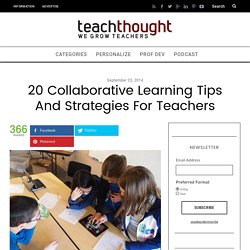
There is an age old adage that says “two heads are better than one”. Educationalresearchtechniques. Cooperative learning is a common term used in education.

Many times, whenever people are working in groups, it is called cooperative learning. However, not just any group work can be called cooperative learning. 20 Collaborative Learning Tips And Strategies For Teachers. The case for collaborative learning. Michael Moran , 16 Jun 2014 The way we design and structure training courses is in a state of flux as we move into the e-learning era and L&D professionals add “social” to the blend.

Resources and Downloads for Collaborative Learning. Educators from The College Preparatory School in Oakland, California, have provided these resources and tools for collaborative learning.
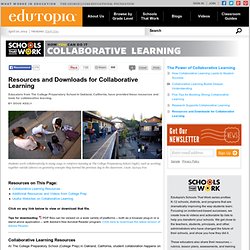
Students work collaboratively in many ways to reinforce learning at The College Preparatory School (right), such as working together outside (above) on geometry concepts they learned the previous day in the classroom. Credit: Zachary Fink. Open Your Classroom Door to 'Be Better' Published Online: May 14, 2013 By Jessica Cuthbertson It's May.
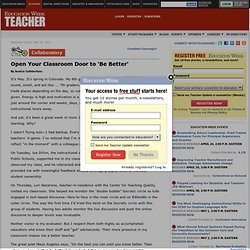
It's spring in Colorado. My 6th graders are starting to sound, smell, and act like ... 7th graders. Sunshine and storms trade places depending on the day, so outdoor recess is not a given. And yet, it's been a great week in room 214. How Twitter is Reinventing Collaboration Among Educators. In the three years that I’ve been building up Edutopia’s presence on social networks like Twitter, Facebook, and YouTube, I’ve noticed a significant shift in how our audience of education changemakers interact and collaborate.

In particular, I’ve seen Twitter reinvent the way educators collaborate to create change in education. Twitter Transforms Educators Before the advent of Twitter, most educators I know had limited opportunities to collaborate with colleagues outside their building. Some subscribed to listservs or participated in online forums, but these outlets lacked critical mass; teachers also networked at in-person conferences and training sessions, but these isolated events didn’t provide ongoing support. Enter Twitter. Global Collaboration Projects for Your Classroom - Global Learning.
Are you ready to integrate technology into your classroom for the first time, just not sure where to begin? Or are you already using technology with your students, and you're ready to go deeper? Either way, the recommendation from Honor Moorman, Associate Director, Professional Development and Curriciulum, Asia Society, is the same. Going Global-Tips And Tricks For Global Collaborations. Creating Successful Collaborations. For the past five years I have collaborated with a playwright who works with my students as they write original plays.
Each year, on the first day that she has been in the room with us, Kate and I stage a conflict about what should come next in the lesson. As students squirm uncomfortably in their seats and turn to each other with unbelieving eyes, Kate and I debate what makes the most sense to do next. The goal of the staged conflict is getting students to think about the crucial role of conflict in drama and playwriting. We use our brief skit as a way to open up a larger conversation about the power of theater and the different elements of a play. Although we never feel that our acting is very convincing, we have been amazed to see and hear the intensity of student responses to these moments of classroom confusion and leadership uncertainty. The Right Mix. PBL Course Development: Collaboration Among Colleagues. Author Jayesh Rao collaborates with his AP Biology design team.
Photo credit: Bill Palmer At Sammamish High School, we're developing and implementing a comprehensive problem-based learning program for all of our students. Working closely with my peers during this process has become one of the highlights of my career as an educator. These last two years I've been granted (literally and figuratively) the space and time to exchange ideas, learn from others and feel the satisfaction of knowing that I grow as a professional with each exchange. I have two very different teacher collaboration experiences to relate. The Key to Empowering Educators? True Collaboration. Teaching Strategies Educators around the world are making a special effort to connect with one another around resources and collaborative opportunities during October, Connected Educator Month.
It’s a time to share ideas, remember that there are others that think alike and find the inspiration to continue to do the tough work of experimenting with teaching strategies that stretch both learners and educators. A key theme this year is how to move from merely connecting with other educators into collaborations that push pedagogy and the education conversation forward. A panel of educators who’ve made this kind of connection and collaboration the center of their work discussed the challenges posed by the current American education system and helped present a dream for what truly collaborative learning could look like. Through connection and collaboration teachers can start down a learning path that parallels the one they try to create for students. Related. Mind Maps for Planning, Collaboration and Assessment.
Last January I wrote about my students’ favorite brainstorming tool, Bubbl.us. How to Teach Math as a Social Activity. 12 Ways to Connect, Create, and Collaborate Using Google Hangouts. Deeper Learning: A Collaborative Classroom Is Key. Starting a New School Year: Nine Tips for Collaboration. Late August or early September is a make-it-or-break-it time for educators. The non-stop, brutal schedule that is a school year starts with all the finesse of trampling elephants, and doesn’t relent for the next nine months (not coincidentally, the same amount of time it takes to gestate a baby).
That makes starting the year right important -- and there are few more critical pieces to an educator's success than collaboration. Collaborating In the Classroom. Collaborative Learning Builds Deeper Understanding. Steve Chabon: Here at the College Preparatory School in Oakland, California, collaborative learning is one of the most important ways our students learn and grow.
Harrison: In math we work in groups every day, asking each other questions before we ask the teacher. Maya: In English, we lead our own round table discussions to deepen our understanding of the books we read. News: Students Working Together, Succeed Together. The Best Sites For Cooperative Learning Ideas. NOTE: You might also be interested in My Best Posts On The Basics Of Small Groups In The Classroom.
Cooperative Learning Strategies. Cooperative Learning Teaching Strategies: Professional Development Resource. Collaborative Learning. According to Webster's Dictionary, a community is "any group living in the same area or having interests, work, etc. in common. " While communities have existed since the beginning of humankind, the growing interest around the concept today is largely a result of the breakdown of the geographic assumption underlying this simple definition.
Most communities - whether online or off - share a number of qualities and characteristics: they are held together by distinct operating norms; members are distinguished by their formal and informal roles; trust must be built to ensure quality interactions; and a shared sense of purpose serves as the glue that bonds the community together. Cooperative Learning Strategies. Global rating average: 0.0 out of 50.00.00.00.00.0.
Eli80085. Four Collaborative Learning Strategies. Cooperative & Collaborative Learning. CL1 - More Information: What is Collaborative Learning? Collaborative Learning. Collaborative Learning Homepage. Cooperative and Collaborative Learning: Explanation. JTE v7n1 - Collaborative Learning Enhances Critical Thinking. Resources and Downloads for Collaborative Learning. Collaborative Learning Builds Deeper Understanding. Research Supports Collaborative Learning. Collaborative math and discussion-based English help to promote deeper learning, critical thinking, and community at The College Preparatory School in Oakland, California. The College Preparatory School (College Prep) in Oakland, California, is among the top 20 best prep schools in the country according to a 2010 Forbes magazine report.
Over the past ten years, 100 percent of students have graduated and matriculated into college, and their average SAT scores have consistently ranked in the top tenth percentile for Math, Critical Reading, and Writing. In addition, more than one-third of students have taken Advanced Placement exams, with at least 95 percent receiving a score of three or higher. Five Tips for Building Strong Collaborative Learning. How Collaborative Learning Leads to Student Success.